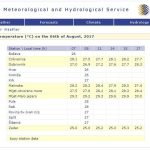August 29, 2018 — Research suggests the top layer of the Adriatic Sea has warmed at an alarming rate over the last six decades, and predicts water levels will rise by about one meter before the end of the century.
The Dalmatian definition of “waterfront property” may change before the end of the century.
Geophysicist Mirko Orlić claims the temperature of the top layer of the Adriatic Sea —— the top 20 meters — has increased by 1,8 degrees Celsius over the last six decades. The rate of increase is also speeding up, as half of the two-degree increase happened over the last 20 years, he added in a wide-ranging interview with morski.hr.
The rising temperatures have already changed the basic character of the sea, with coral dying off and new species of invasive algae and fish taking advantage of the warmer waters. The geophysicist at the Department of Science and Mathematics at the University of Zagreb and the Croatian Academy of Sciences and Arts said the rapidly-changing climate spells trouble for nearly all varieties of life that live in or close to the sea — including people.
“It is [promising] for human and animal species, also plant species as well as for a living organism such as the sea in the near future,” Orlić said in the interview.
Aside from warming, the sea’s level is rising. At the current rate, it’ll increase by about one meter by the end of the century, according to Orlić.
The researcher didn’t mince words about the source: global warming, particularly the increase of greenhouse gases in the atmosphere which has a cascading effect upon the planet’s intricate climate system.
Orlić’s warnings mimic a report by Ocean-Lab, which claimed the Adriatic Sea was as much as three degrees Celsius warmer in June. Earlier this summer, the World Wildlife Foundation also warned too much of Croatia’s plastic isn’t recycled, much of it ending up in the sea.
The Adriatic specifically has been heated up so much, regulars can attest to its warming temperatures; whereas summer beachgoers often swam in 25-degree waters, today the figure has jumped to 27 degrees.
These sorts of increases open the door for invasive tropical species from the Mediterranean, which can overwhelm the existing local fish and coral.
A dissection of the sea’s remaining layers also indicates the exchange of water between the Adriatic and Mediterranean has weakened.
Aside from the increase in the mean temperature, Orlić said seas experience prolonged periods of temperature change similar to the heat waves people experience on land. These “marine thermal waves” have become more common, more intense and longer-lasting.
The overall change in sea temperature will have little effect on the tourism industry directly, though the increasing heat may ward off visitors during the hottest summer months, according to Orlić. The temperature increases will, however, affect fishermen — though exactly how isn’t known.
The worst-case scenario, as spelled out by Orlić, mirrors that of most other scientists. With no changes to the current output of greenhouse gases, the global map of arable land will be wildly contorted, leading to mass migration, famine and perhaps even war. Existing waterfront property now merges with parts of the seabed, as water levels rise by as much as one meter.
The best case scenario, at this point, is sticking to the Paris Climate Accord, which aims to lower greenhouse gas emissions to global warming reaches a mere 2 degrees Celsius — a figure which would still radically change the Earth’s landscape, but limit the most disastrous effects.











